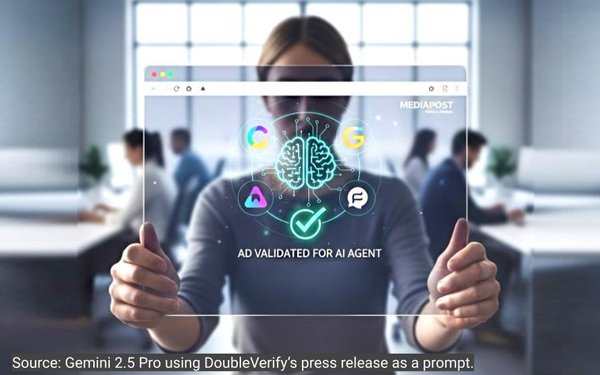
In what appears to be an industry-first shift that will enable
advertisers to verify ads served to validated AI agents, ad-fraud filtering service DoubleVerify this morning unveiled the rollout of a new "DV AI Verification" service.
Unlike previous
generations of brand-safety services used to exclude bots by filtering non-human traffic deemed advertising fraud, the new AI verification service is a recognition that advertisers may begin including
ads served to valid AI agents representing human consumers as part of a shift to agent-to-agent marketing, or A2A.
“Some agents will be benign, some malicious, and some might be personal
retail agents crawling around looking at ads,” DoubleVerify CEO Mark Zagorski explained to MediaPost, adding: “Engagement with ads is increasingly coming from non-human sources.”
In other words, the new AI verification service is designed to exclude invalid agents, but include valid ones deemed a proxy for human consumers that the brand is seeking to reach and
influence.
advertisement
advertisement
DoubleVerify said the AI verification service will begin offering "an initial series of capabilities" by year-end, with more coming available in 2026.
While the company did
not provide explicit details about which agents may be included or excluded, it described ChatGPT, Claude and Perplexity as "declared agents" vs. unnamed "undeclared, potentially malicious AI
bots."
It also cited "emerging personal and retail agents" that "advertisers are being challenged to navigate a digital ecosystem populated by a new generation of opportunities and
threats."
DoubleVerify says it already analyzes nearly 2 billion interactions with declared and undeclared AI agents.
DoubleVerify Head of Fraud and AI Lab Gilit Saporta said the
company categorizes its data on three different types of agentic interactions, and provided an example of how agents work on behalf of consumers and why advertisers should think differently about
serving ads to bots.
“My kids are now at the age where they are into hair products, but I don’t have the time to go to each individual website,” Saporta said.
She
goes to Comet and types “find me something with a peach flavor” because this is a scent her son likes, and gives the browser permission to shop for her. The agentic browser makes actions
on Saporta’s behalf.
“We know that in a few of these scenarios the bots ingest ads, whether or not the user is aware,” Saporta said. “There can be a lot of obstacles as
the bot tries to complete the purchase, which can skew the number of clicks and impressions generated."
While humans may never see the ad, without accurate measurement, it may still be
considered a valid ad impression.
DoubleVerify also characterizes interactions from AI browsers as "measurable agentic interactions."
Saporta said agents may attempt to click on
the wrong side of the page and a commerce site may not have the correct protocol to complete the purchase, which can skew the number of clicks and impressions generated.
And while humans may
never see the ad, it may still be deemed a valid ad impression if a valid agentic agent identifies it.
“We are seeing different levels of sophistication and maturity in the coding of
scrapers," Saporta said. "Not all are from well-known companies.“
Many are not mature enough to do price aggregation and are not ready to take on specific tasks. Much of the traffic
seen today goes beyond providing agents with known directions to take.
DoubleVerify also released “AI SlopStopper for Open Web,” expanding on its Gen AI Website Avoidance and
Detection tool introduced in December 2024.
AI SlopStopper for the open web expands on that capability and is now integrated into the DV AI Verification offering to help advertisers avoid
low-quality, AI-generated content and measure media quality across programmatic environments.